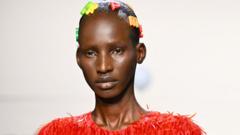In recent seasons, the fashion industry has seen a notable shift back to an emphasis on thinness, reviving the trend that body positivity initially sought to dismantle. Once a beacon of inclusive representation, the catwalks barely feature plus-size models anymore, as many designers focus on skinnier silhouettes.
The body positivity movement gained momentum in the 2010s, promoting the acceptance of diverse body types, largely aided by social media influencers and cultural icons. Models like Ashley Graham paved the way, celebrating curves and showcasing a variety of body sizes on prominent runways and in major campaigns. For a moment, it seemed the industry was awakening to the idea that beauty transcends conventional standards.
However, an analysis of recent fashion weeks in major cities indicates a reversal in this trend. At the latest Paris Fashion Week, reports highlighted that a mere 0.8% of the 8,800 looks were represented by plus-size models, reflecting a dramatic decline in diversity. The fasting-paced rise of weight loss drugs like Ozempic has coincided with this return to favoring skinnier models, as both influencers and celebrities endorse such medications for quick slimming results.
While some models have expressed their joy at the perceived increase in job opportunities linked to a resurgence of thinness, others grapple with the anxiety of maintaining an unrealistic body image. Industry insiders are becoming increasingly vocal about the dangers of this shift. Chioma Nnadi, editorial director of British Vogue, acknowledges the ongoing concern regarding the pendulum swinging back “to skinny” and the impact of medications on this narrative.
Moreover, the creative director of the brand Namilia recently sparked controversy with a tongue-in-cheek “I love Ozempic” shirt during their showcase, which resonated strongly with the frustrations surrounding current beauty norms.
Yet, not all designers are retreating to outdated ideals. Some, like Charles Jeffrey, argue for a moral responsibility to represent all body types, insisting that diversity must be interwoven into the brand's ethos rather than viewed as a marketing strategy. However, such perspectives appear to be in the minority.
The future of body representation in fashion remains uncertain, yet experts suggest that consumer preferences could drive change. There is a call for the community to challenge brands and advocate for inclusivity by altering buying habits. The cyclical nature of fashion suggests that trends eventually shift again, but the path back to genuine inclusivity in the fashion world feels fraught with hurdles.
The body positivity movement gained momentum in the 2010s, promoting the acceptance of diverse body types, largely aided by social media influencers and cultural icons. Models like Ashley Graham paved the way, celebrating curves and showcasing a variety of body sizes on prominent runways and in major campaigns. For a moment, it seemed the industry was awakening to the idea that beauty transcends conventional standards.
However, an analysis of recent fashion weeks in major cities indicates a reversal in this trend. At the latest Paris Fashion Week, reports highlighted that a mere 0.8% of the 8,800 looks were represented by plus-size models, reflecting a dramatic decline in diversity. The fasting-paced rise of weight loss drugs like Ozempic has coincided with this return to favoring skinnier models, as both influencers and celebrities endorse such medications for quick slimming results.
While some models have expressed their joy at the perceived increase in job opportunities linked to a resurgence of thinness, others grapple with the anxiety of maintaining an unrealistic body image. Industry insiders are becoming increasingly vocal about the dangers of this shift. Chioma Nnadi, editorial director of British Vogue, acknowledges the ongoing concern regarding the pendulum swinging back “to skinny” and the impact of medications on this narrative.
Moreover, the creative director of the brand Namilia recently sparked controversy with a tongue-in-cheek “I love Ozempic” shirt during their showcase, which resonated strongly with the frustrations surrounding current beauty norms.
Yet, not all designers are retreating to outdated ideals. Some, like Charles Jeffrey, argue for a moral responsibility to represent all body types, insisting that diversity must be interwoven into the brand's ethos rather than viewed as a marketing strategy. However, such perspectives appear to be in the minority.
The future of body representation in fashion remains uncertain, yet experts suggest that consumer preferences could drive change. There is a call for the community to challenge brands and advocate for inclusivity by altering buying habits. The cyclical nature of fashion suggests that trends eventually shift again, but the path back to genuine inclusivity in the fashion world feels fraught with hurdles.



















